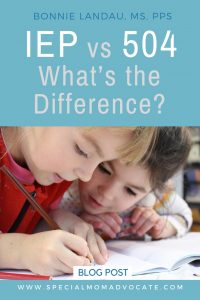 In the United States, if your child is unable to complete schoolwork with the same method and competence as peers, some kind of educational plan may be drafted, approved and implemented to assist. Reasons for needing help could include behavioral emotional, academic or medical issues. In any of these cases, the process for creating the plan will be similar. The resulting support document would be an IEP (Individualized Education Program) or a 504 (Section 504 Plan).
In the United States, if your child is unable to complete schoolwork with the same method and competence as peers, some kind of educational plan may be drafted, approved and implemented to assist. Reasons for needing help could include behavioral emotional, academic or medical issues. In any of these cases, the process for creating the plan will be similar. The resulting support document would be an IEP (Individualized Education Program) or a 504 (Section 504 Plan).
You have heard of IEPs and 504s, but do you know which plan your child qualifies for? What’s the difference between an IEP vs 504 Plan? Why two different names? Which plan the child falls under is determined by the severity of the disability and the services required to assist the child in the learning environment.
Individualized Education Program
An IEP (individualized education plan) is created for a student who needs specialized instruction or services based on the guidelines established in the Individuals with Disabilities Education Act (IDEA). A child who has an IEP has some disability that effects how they learn and difficulty accessing the learning environment. The student requires additional services that a general education teacher cannot provide. For example, a student with vision issues may be allowed to work on a special computer that magnifies text. Another example would be a child who struggles with writing (dysgraphia) and requires an occupational therapist to assist in building physical writing skills.
One key distinction of an IEP vs. 504 is the ability to modify curriculum. In the IEP they can reduce the classwork, homework or have different standards for grading assignments. In a 504 curriculum cannot be modified. For example, a student with an IEP may be excused from homework or not have to be tested on all words for a spelling test.
IEP plans are determined with input from the IEP team, which includes the parent, who is definitely the topmost specialist on their child! The IEP team meeting is focused on creating goals with measurable outcomes to help the student improve. The IEP is reviewed annually and the child is tri-annual reassessment every 3 years to determine if they still qualify for services. IEP plans usually cost the school money because of the additional support services required. While theoretically the federal government pays 40% of these services, the truth is only 16% of services are covered by the federal government. The rest of the cost are covered by state and school district funds.
504 Plan
A 504 Plan is used for students who have a disability that makes it difficult for them to complete their schoolwork or participate in class. Usually the disability is not as pervasive as a child with an IEP. A child with a 504 would not receive any services outside the classroom, but instead would receive accommodations in the classroom to help equalize the playing field so their disability does not put them behind their peers. For example, if a child has a hearing impairment, the child would get to sit in the front of the classroom to hear the teacher more easily. Similarly a child with dyslexia may be given more time on tests or may be given written class notes. A 504 can also be drafted for a child with medical or mental disabilities, such cancer or bipolar disorder. Section 504 of the Rehabilitation Act covers the accommodations that are provided under a 504 plan.
With a 504, the general education curriculum is never modified. Instead the student is given accommodations to make it easier to complete work. For example, while the student with a 504 must do all the homework, he or she may be given extra days to turn it in.
A 504 plan is decided on after meetings with parents, teachers and special education specialists at the school. A diagnosis of a disability is required, although the school may offer testing to determine if a child qualifies. After a discussion about what needs to be put in place to help the child achieve his or her potential, specific classroom accommodations are decided on. The law does not require an annual review of a 504 Plan, but it is considered good practice to do so. It would need to be refreshed if the child were to change schools. A 504 plan can be implemented without extra services, so it does not usually incur any additional cost for the school.
ABOUT THE AUTHOR:
Bonnie Landau is a professional counselor and holistic therapist in Ventura County, California. Her specialities include therapy for autism, therapy for ADHD, and therapy for parenting who have kids with autism or ADHD or other neurodivergence. She changed careers from graphic design to counseling with the goal of helping struggling parents of kids with ADHD, autism, or other neurodivergence find strategies and solutions to help their children succeed. Bonnie is also the author of Special Ed Mom Survival Guide: How to Prevail in the Special Education Process and Find Life-long Strategies for You and Your Child.


